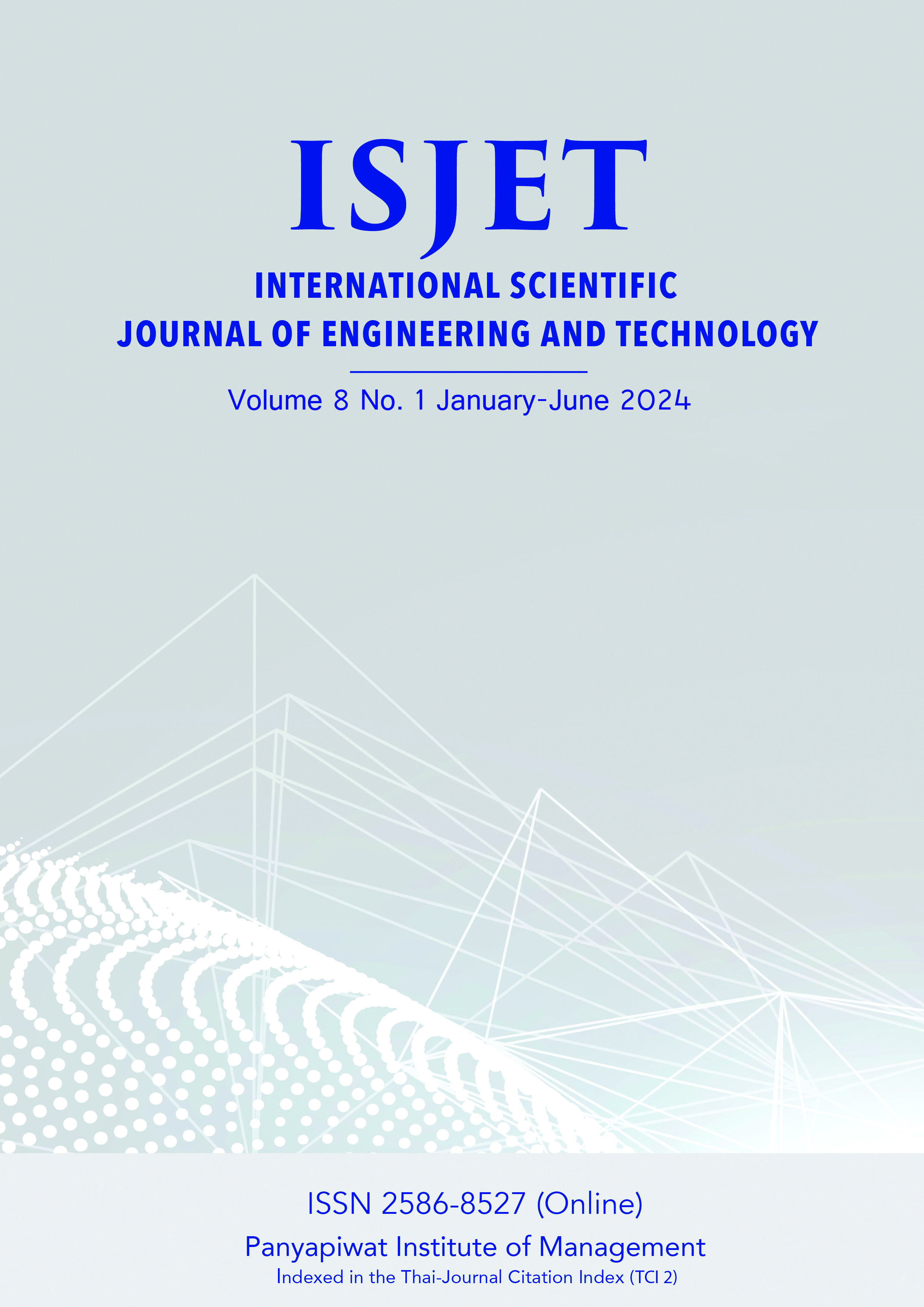Development of Crispy Spicy Snack from Bhutan Oyster Mushroom by-Product with Narok Chili Paste
Main Article Content
Abstract
The aim of this study is to develop a crispy spicy snack from Bhutan oyster mushroom by-product and Narok chili paste. It was rejected
from the mushroom house with an evaporation system at Wat Jampee school, Suphan Buri province. The methodology of this study is the preparation of three different sizes of oyster mushroom by-products; shreded, medium, and whole mushrooms. They were then blanched in hot water, cooled in cold water, soaked in 1% Calcium Chloride (CaCl2) for 15 min., drained and dipped in batter, and deep fried at 160 °C in vegetable oil. The shred and medium size of mushrooms took 8 min. and 10 min. for the whole mushroom. It was then, baked at 90°C for 50 min. It was found that the shred and medium-sized oyster mushroom by-products had the exact overall liking at 6.90 at a slightly liking level. To select the standard recipe for Narok chili paste and the most appropriate size of mushroom by target customer for further product development. The experiment found that shredded mushrooms with Narok chili paste recipe
1 (T1S1) from six samples received the highest overall preference score of 6.10. As for the sensory evaluation with a 9-point Hedonic Scale found that the shredded mushroom with the first recipe chili paste got moderate overall liking (7.06), the color of the mushroom (7.09), crispiness (7.04) chili paste color (7.49), spiciness (6.90), saltiness (6.52). The consumer acceptance was 77%. Hence, the study of the development of a crispy spicy Bhutan Oyster Mushroom by-product snack from the mushroom house with an evaporation system at Wat Jampee School, Suphan Buri province, add value to the by-product until the country’s economic sustainability in the future.
Article Details

This work is licensed under a Creative Commons Attribution-NonCommercial-NoDerivatives 4.0 International License.
เนื้อหาข้อมูล
References
S. Nanamchok, “Snack Marketing Factors of Affecting Buying Decision, a Case Study of Personnel in Department of Health, Ministry of Public Health,” M.S. thesis, Dept. M.B.A., Burapha Univ., Chonburi, Thailand, 2019.
P. Yinglertratanakul. (2003, Apr. 26). A Study of Energy Content in Snacks and Snacks. [Online]. Available: https://nutrition2.anamai.moph.go.th/th/research2/download?id=78312&mid=35886&mkey=m_document&lang=th&did=25210
Y. Saowaphruek. (2018, Dec. 22). Healthy Food and Drink Trends. [Online]. Available: https://www.prachachat.net/ columns/news-268743
P. Prachongpun, L. Pankaew, and R. Chunhom, “Production Calcium-Supplemented Snack from Salmon Fishbone Powder through Extrusion Process,” VRU Research and Development Journal Science and Technology, Valaya Alongkorn Rajabhat University, vol. 18, no. 3, p. 153, Oct. 2023.
B. Niarnam. (2014, Jun. 2). Mushroom Farm. [Online]. Available: https://farmhet.wordpress.com/ระบบ-evaporative-evap/
C. Wongpaosakul. (2012, Mar. 12). Pleurotus SP. Mushroom Selection with Mono-Mono Crossing. [Online]. Available: https://shorturl.asia/tLmRK
Ministry of Agriculture and Cooperatives. (2012, Nov. 16). National Bureau of Agricultural Commodity and Food Standards. Available: https://www.acfs.go.th/standard/ download/eng/PLEUROTUS_MUSHROOMs_ENG.pdf
D. Pongpal. (2020, May. 12). Mushroom Production [Online]. Available: http://mdc.library.mju.ac.th/ebook/335131.pdf
T. Paraapakul, T. Supakitvanitchkul, and P. Pattarajittimakul. (2021, Dec. 20). Thai Herbed Pork Chili Paste. [Online]. Available: https://e-research.siam.edu/wp-content/uploads/2022/03/Liberal-Arts-Tourism-and-HospitalityIndustry-2021-coop-Thai-Herbed-Pork-Chili-Paste1.pdf
P. Mania. (2012, Sep. 5). Narok Chilli Paste Recipe. [Online]. Available: http://namp,rik-thai.blogspot.com/2012/05/blog-post.html
K. Kanpairo, P. Aeidtem, and P. Phalachai. “Product Development and Shelf life of Seasoning Fried SAJOR–CAU Mushroom: Case Study in Tanto Yala.” B.S. thesis, Dept. Science Technology and Agricultural, Yala Rajabhat Univ., Yala, Thailand, 2020.
R. Konkhamba and A. Duangkhai. “The Effects of Drying Conditions and Package on the Okra Crispy Snack Quality.” B.S. thesis, Dept. Food Science and Technology, Ubon Ratchathani Rajabhat Univ., Ubon Ratchathani, Thailand,
B. M. Watts, G. L. Ylimaki, L. E. Jeffery et al., Basic Sensory Methods for Food Evaluation. University of Minnesota, Twin Cities: Minnesota, 1989, pp. 1-160.
T. Sirilert and N. Silalai, “Effect of Pre-Frying Treatments on Moisture Content, Effective Moisture Diffusivity and Oil Uptake Content of Deep-Fat Fried Shitake Mushrooms (Lentinusedodes),” Journal of Food Technology, Siam University, vol. 11, no. 1, pp. 57-65, Jan. 2016.
J. Sangkarnjanawanich, N. Boonbrahm, P. Kattalo et al., “Product Development of Crispy Sajor-caju Mushroom,” B.S. thesis, Dept. Agro-Industry, Ubon Ratchathani Univ., Ubon Ratchathani, Thailand, 2005.
Institute of Food Research and Product Development. (2016, Jan. 6). Dried Shrimp Narok Chili Paste. [Online]. Available: https://hectortarr.arda.or.th/api/uploaded_file/AKQrJEy2P0s8VZk7d9I3z
R. Mekwilai, Namprik Kreungjim. Bangkok, THA: Wadsilp, 2008, p. 48.
S. Chaichana, Millinaire Chili Paste, Maeban, Bangkok, THA: Maeban, 2018, p. 83.
R. Steel, J. Torrie, and D. Dickey, Principles and Procedures of Statistics: A Biometrical Approach. New York: McGraw-Hill, 1980, p. 633.
B. Sawetwongsakul. (2010, Nov. 24). Study on Processing of Crispy Seasoned Grey Oyster Mushroom. [Online]. Available: https://kruvijai.files.wordpress.com/2010/11/24-agro-bunyawaree.pdf
Thai Industrial Standards Institute. (2003, Mar. 13). The Local Standard of Seasoning Mushroom Product. [Online]. Available: https://www.nkw.ac.th/courseware/www.nectec.or.th/courseware/siamculture/otop-tis/tcps303_47.pdf

